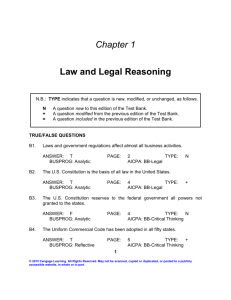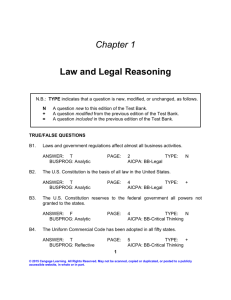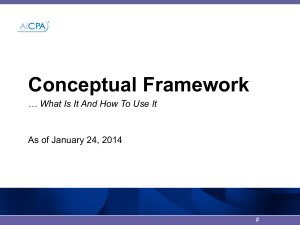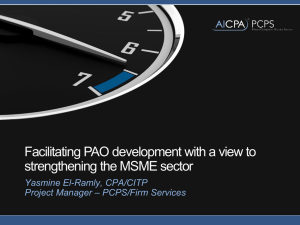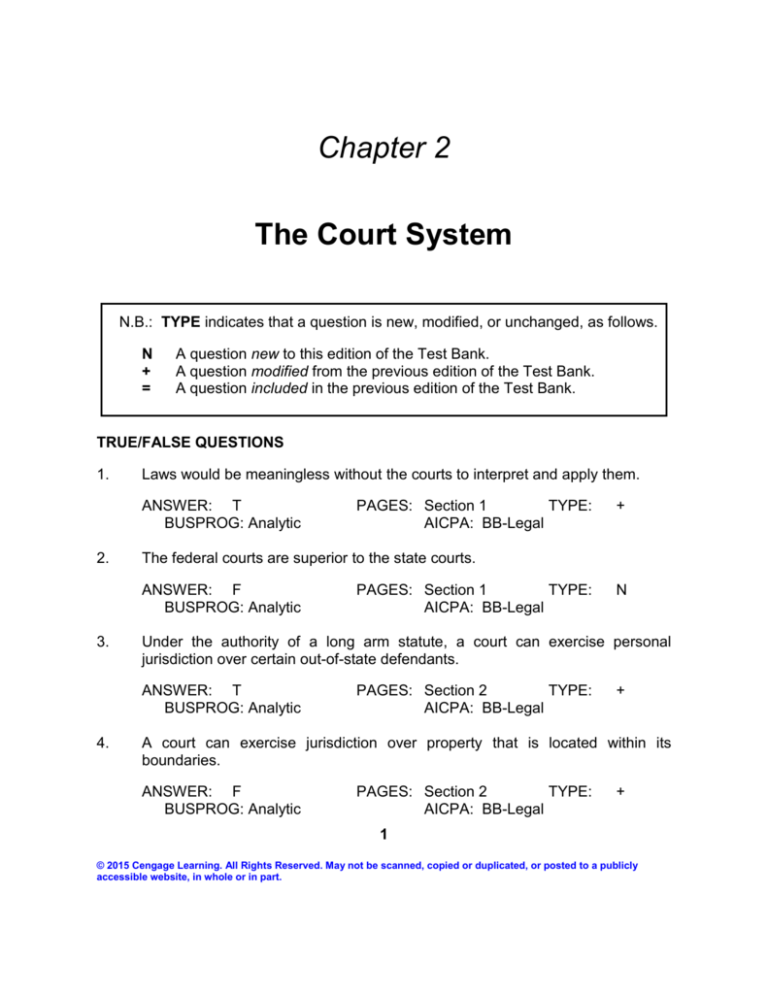
Chapter 2
The Court System
N.B.: TYPE indicates that a question is new, modified, or unchanged, as follows.
N
+
=
A question new to this edition of the Test Bank.
A question modified from the previous edition of the Test Bank.
A question included in the previous edition of the Test Bank.
TRUE/FALSE QUESTIONS
1.
Laws would be meaningless without the courts to interpret and apply them.
ANSWER: T
BUSPROG: Analytic
2.
PAGES: Section 1
TYPE:
AICPA: BB-Legal
N
Under the authority of a long arm statute, a court can exercise personal
jurisdiction over certain out-of-state defendants.
ANSWER: T
BUSPROG: Analytic
4.
+
The federal courts are superior to the state courts.
ANSWER: F
BUSPROG: Analytic
3.
PAGES: Section 1
TYPE:
AICPA: BB-Legal
PAGES: Section 2
TYPE:
AICPA: BB-Legal
+
A court can exercise jurisdiction over property that is located within its
boundaries.
ANSWER: F
BUSPROG: Analytic
PAGES: Section 2
TYPE:
AICPA: BB-Legal
+
1
© 2015 Cengage Learning. All Rights Reserved. May not be scanned, copied or duplicated, or posted to a publicly
accessible website, in whole or in part.
2
TEST BANK—UNIT ONE: THE FOUNDATIONS
5.
Because corporations are not considered legal persons, courts use different
principles to determine whether it is fair to exercise jurisdiction over a
corporation.
ANSWER: F
BUSPROG: Analytic
6.
PAGES: Section 2
TYPE:
AICPA: BB-Legal
+
PAGES: Section 3
TYPE:
+
AICPA: BB-Critical Thinking
Procedural law does not have a significant impact on a person’s ability to
pursue a legal claim.
ANSWER: F
BUSPROG: Analytic
11.
N
U.S. district courts have concurrent jurisdiction with state courts in matters
involving federal questions.
ANSWER: F
BUSPROG: Reflective
10.
PAGES: Section 2
TYPE:
AICPA: BB-Legal
To have standing to sue, a party must have complaining sufficient stake in a
matter to justify seeking relief through the court system.
ANSWER: T
BUSPROG: Analytic
9.
PAGES: Section 2
TYPE:
N
AICPA: BB-Critical Thinking
For purposes of diversity of citizenship, a corporation is a citizen only of the
state in which its principal place of business is located.
ANSWER: F
BUSPROG: Analytic
8.
N
The minimum-contacts requirement is usually met if a corporation advertises or
sells its products within a state.
ANSWER: T
BUSPROG: Reflective
7.
PAGES: Section 2
TYPE:
AICPA: BB-Legal
PAGES: Section 4
TYPE:
AICPA: BB-Risk Analysis
N
The litigation process has three phases: filing, answering, and appealing.
ANSWER: F
BUSPROG: Analytic
PAGES: Section 4
TYPE:
AICPA: BB-Legal
+
© 2015 Cengage Learning. All Rights Reserved. May not be scanned, copied or duplicated, or posted to a publicly
accessible website, in whole or in part.
CHAPTER 2: THE COURT SYSTEM
12.
Only a defendant can file a motion to dismiss.
ANSWER: F
BUSPROG: Analytic
13.
N
PAGES: Section 4
TYPE:
AICPA: BB-Legal
N
PAGES: Section 4
TYPE:
AICPA: BB-Legal
N
After both sides have rested their cases, only the plaintiff’s attorney makes a
closing argument.
ANSWER: F
BUSPROG: Analytic
18.
PAGES: Section 4
TYPE:
AICPA: BB-Legal
An expert witness is a person who is directly involved in the events concerning
a lawsuit.
ANSWER: F
BUSPROG: Analytic
17.
N
Any written material, including information stored electronically, can be the
object of a discovery request.
ANSWER: T
BUSPROG: Analytic
16.
PAGES: Section 4
TYPE:
AICPA: BB-Legal
Interrogatories are written questions for which written answers are prepared by
a judge.
ANSWER: F
BUSPROG: Analytic
15.
PAGES: Section 4
TYPE:
N
AICPA: BB-Critical Thinking
The use of additional evidence distinguishes the motion for summary judgment
from the motion for judgment on the pleadings.
ANSWER: T
BUSPROG: Analytic
14.
3
PAGES: Section 4
TYPE:
AICPA: BB-Legal
N
Either party may appeal a jury’s verdict but only the defendant may appeal a
judge’s ruling.
ANSWER: F
BUSPROG: Analytic
PAGES: Section 4
TYPE:
AICPA: BB-Legal
N
© 2015 Cengage Learning. All Rights Reserved. May not be scanned, copied or duplicated, or posted to a publicly
accessible website, in whole or in part.
4
TEST BANK—UNIT ONE: THE FOUNDATIONS
19.
A court of appeals does not hear any evidence.
ANSWER: T
BUSPROG: Analytic
20.
PAGES: Section 4
TYPE:
AICPA: BB-Legal
N
It is guaranteed that any judgment will be enforceable.
ANSWER: F
BUSPROG: Reflective
PAGES: Section 4
TYPE:
AICPA: BB-Risk Analysis
N
MULTIPLE-CHOICE QUESTIONS
1.
As a judge in a federal court, Christine can decide, among other things,
whether the laws or actions of the executive and legislative branches are
constitutional. The process for making this determination is known as
a.
b.
c.
d.
judicial review.
jurisdiction.
venue.
early neutral case evaluation.
ANSWER: A
BUSPROG: Reflective
2.
PAGES: Section 1
TYPE:
AICPA: BB-Legal
N
A Maryland state court can exercise jurisdiction over National Insurance
Corporation, an out-of-state company, if the firm has
a.
b.
c.
d.
minimum contacts with the state.
maximum contacts with the state.
medium contacts with the state.
no contacts with the state.
ANSWER: A
BUSPROG: Reflective
PAGES: Section 2
TYPE:
N
AICPA: BB-Decision Modeling
© 2015 Cengage Learning. All Rights Reserved. May not be scanned, copied or duplicated, or posted to a publicly
accessible website, in whole or in part.
CHAPTER 2: THE COURT SYSTEM
3.
Fresh Harvest Company, which is based on Georgia, packages and sells
vegetables. Hayden, who is a resident of Indiana, buys a Fresh Harvest product,
eats it, and suffers severe food poisoning. Hayden wants to file a suit against
Fresh Harvest. The diversity of citizenship between these parties means that
a.
b.
c.
d.
federal and state courts have concurrent jurisdiction.
federal courts have exclusive jurisdiction.
no court has jurisdiction.
state courts have exclusive jurisdiction.
ANSWER: A
BUSPROG: Reflective
4.
PAGES: Section 2
TYPE:
AICPA: BB-Legal
N
Lewis wants to file a suit against Mikayla. Before any court can hear the case
a.
b.
c.
d.
the parties to the dispute must agree.
the court must have jurisdiction.
the court must issue a deposition.
the parties must own property.
ANSWER: B
BUSPROG: Reflective
5.
5
PAGES: Section 2
TYPE:
AICPA: BB-Legal
N
Marcus files a suit against Naomi in an Ohio state court. Naomi’s only connection to Ohio is an ad on the Web originating in Pennsylvania. For Ohio to
exercise jurisdiction, the issue is whether Naomi, through her ad, has
a.
b.
c.
d.
a commercial cyber presence in Ohio.
conducted substantial business with Ohio residents.
claimed to be a resident of Ohio.
solicited virtual business in Ohio.
ANSWER: B
BUSPROG: Reflective
PAGES: Section 2
TYPE:
AICPA: BB-Legal
+
© 2015 Cengage Learning. All Rights Reserved. May not be scanned, copied or duplicated, or posted to a publicly
accessible website, in whole or in part.
6
TEST BANK—UNIT ONE: THE FOUNDATIONS
6.
Arnold loses his suit against Buffy in a Colorado state trial court. Arnold appeals to a state intermediate court of appeals and loses again. Arnold would
appeal next to
a.
b.
c.
d.
a U.S. district court.
the Colorado Supreme Court.
the United States Supreme Court.
the U.S. Court of Appeals for the Ninth Circuit.
ANSWER: B
BUSPROG: Reflective
7.
The Montana Supreme Court rules against Natural Grocery Mart in a case
against One Stop 2 Shop Stores, Inc. Natural Grocery files an appeal with the
United States Supreme Court. The Court does not hear the case. This
a.
b.
c.
d.
is a decision on the merits that has value as a precedent.
indicates agreement with the Montana court’s decision.
means nothing.
means that the Montana court’s decision is the law in Montana.
ANSWER: D
BUSPROG: Reflective
8.
PAGES: Section 3
TYPE:
=
AICPA: BB-Critical Thinking
PAGES: Section 3
TYPE:
AICPA: BB-Legal
=
The Iowa Supreme Court rules against Jennifer in a case against Kut-Rate
Stores, Inc. Jennifer wants to appeal her case to the United States Supreme
Court. She must ask the Court to issue a writ of
a.
b.
c.
d.
appeal.
certiorari.
jurisdiction.
summons.
ANSWER: B
BUSPROG: Reflective
PAGES: Section 3
TYPE:
N
AICPA: BB-Critical Thinking
© 2015 Cengage Learning. All Rights Reserved. May not be scanned, copied or duplicated, or posted to a publicly
accessible website, in whole or in part.
CHAPTER 2: THE COURT SYSTEM
9.
Gilbert wants to initiate a suit against Healthways Insurance Company by filing
a complaint. The complaint should include
a.
b.
c.
d.
an explanation of the proof to be offered at trial.
a statement refuting any defense that the defendant might assert.
a motion for judgment on the pleadings.
a statement alleging the facts showing the court has jurisdiction.
ANSWER: D
BUSPROG: Reflective
10.
PAGES: Section 4
TYPE:
AICPA: BB-Legal
+
Ballpark Sportsfield, Inc., files a suit against Concessions & Tailgate Services.
The document that informs Concessions & Tailgate that it must file an answer
within a specified time period is
a.
b.
c.
d.
the answer.
the complaint.
the writ of certiorari.
the summons.
ANSWER: D
BUSPROG: Reflective
11.
7
PAGES: Section 4
TYPE:
AICPA: BB-Legal
+
Neville files a suit against Olina. If Olina fails to respond,
a.
b.
c.
d.
Neville must appeal the case to a different court.
Olina’s failure to respond will be considered to be a denial.
Neville will not be awarded the remedy sought.
Olina will have a default judgment entered against her.
ANSWER: D
BUSPROG: Reflective
PAGES: Section 4
TYPE:
AICPA: BB-Legal
N
© 2015 Cengage Learning. All Rights Reserved. May not be scanned, copied or duplicated, or posted to a publicly
accessible website, in whole or in part.
8
TEST BANK—UNIT ONE: THE FOUNDATIONS
12.
Lyn files a suit against Karl. Karl denies Lyn’s charges and sets forth his own
claim that Lyn breached their contract and owes Karl money for the breach.
Karl’s claim is
a.
b.
c.
d.
counterclaim.
motion for judgment on the pleadings.
motion for summary judgment.
motion to dismiss.
ANSWER: A
BUSPROG: Reflective
13.
N
Renewable Resources, Inc., files a suit against Sunrich Utility Company and
seeks to examine certain documents in Sunrich’s possession. A legitimate
reason for this examination is that the documents contain
a.
b.
c.
d.
information that is relevant to the case.
private information about Sunrich’s operations.
public information about energy generation.
irrelevant data that can be eliminated from consideration.
ANSWER: A
BUSPROG: Reflective
14.
PAGES: Section 4
TYPE:
AICPA: BB-Legal
PAGES: Section 4
TYPE:
AICPA: BB-Legal
+
To prepare for a trial between SmartPhones, Inc., and TechApps Company,
TechApps’ attorney places SmartPhones’ chief executive officer (CEO) under
oath. A court official makes a record of the attorney’s questions and the CEO’s
answers. This is
a.
b.
c.
d.
a cross-examination.
a deposition.
voir dire.
an interrogatory.
ANSWER: B
BUSPROG: Reflective
PAGES: Section 4
TYPE:
AICPA: BB-Legal
+
© 2015 Cengage Learning. All Rights Reserved. May not be scanned, copied or duplicated, or posted to a publicly
accessible website, in whole or in part.
CHAPTER 2: THE COURT SYSTEM
15.
During the trial phase of Sof’ Drink Soda Corporation’s suit against TimeOut
Convenience Stores, Inc., their attorneys engage in voir dire. This is
a.
b.
c.
d.
an assessment of the arguments on the issues.
the determination of the issues to be argued.
the testimony by a party to the lawsuit or by any witness, recorded by an
authorized court official.
the selection of jurors.
ANSWER: D
BUSPROG: Reflective
16.
PAGES: Section 4
TYPE:
AICPA: BB-Legal
+
Jenna files a civil suit against Keshia. To succeed, Jenna must prove her case
a.
b.
c.
d.
beyond a reasonable doubt.
by a preponderance of the evidence.
by indisputable proof.
to the extent promised in her attorney’s opening statement.
ANSWER: B
BUSPROG: Reflective
17.
9
PAGES: Section 4
TYPE:
AICPA: BB-Legal
+
In Hazel’s suit against Ingrid, the court issues a judgment in Ingrid’s favor. If the
case is appealed to an appropriate court of appeals, the appellate court will
hear
a.
b.
c.
d.
all of the evidence.
most of the evidence.
none of the evidence.
select pieces of evidence.
ANSWER: C
BUSPROG: Reflective
PAGES: Section 4
TYPE:
AICPA: BB-Legal
=
© 2015 Cengage Learning. All Rights Reserved. May not be scanned, copied or duplicated, or posted to a publicly
accessible website, in whole or in part.
10
TEST BANK—UNIT ONE: THE FOUNDATIONS
Fact Pattern 2-1 (Questions 18–20 apply)
Martin files a suit against Nichelle in a state court over payment due on a short-term
employment contract. The case proceeds to trial, after which the court renders a
verdict. The case is appealed to an appellate court.
18.
Refer to Fact Pattern 2–1. After its review of Martin v. Nichelle, the appellate
court upholds the lower court’s verdict. The appellate court has
a.
b.
c.
d.
affirmed the case.
reversed the case.
remanded the case.
reversed and remanded the case.
ANSWER: A
BUSPROG: Reflective
19.
N
Refer to Fact Pattern 2–1. After a final determination in the case of Martin v.
Nichelle, any judgment will be satisfied
a.
b.
c.
d.
if the losing party pays the judgment.
if the winning party has sufficient assets to cover the amount of
damages sought.
if the losing party proves that he or she is unable to pay the judgment.
all of the choices.
ANSWER: A
BUSPROG: Reflective
20.
PAGES: Section 4
TYPE:
AICPA: BB-Legal
PAGES: Section 4
TYPE:
N
AICPA: BB-Critical Thinking
Refer to Fact Pattern 2–1. After the state’s highest court’s review of Martin v.
Nichelle, a party can appeal the decision to the United States Supreme Court if
a.
b.
c.
d.
a federal question is involved.
a question of state law remains unresolved.
the party is unsatisfied with the result.
the state trial and appellate court rulings are different.
ANSWER: A
BUSPROG: Reflective
PAGES: Section 4
TYPE:
AICPA: BB-Legal
=
© 2015 Cengage Learning. All Rights Reserved. May not be scanned, copied or duplicated, or posted to a publicly
accessible website, in whole or in part.
CHAPTER 2: THE COURT SYSTEM
11
ESSAY QUESTIONS
1.
Chase is injured in an accident while driving an off-road vehicle made by
Drivers Edge, Inc., an out-of-state corporation. Chase files a suit against
Drivers Edge, alleging negligence, and mails a summons and a copy of the
complaint to the firm by certified mail, return receipt requested. The envelope is
addressed in part to “Elvin, President, Drivers Edge, Inc.” The receipt is
returned with the signature of “Francine,” a Drivers Edge employee. A U.S.
Postal employee later testifies that Francine usually receives mail on Drivers
Edge’s behalf. Drivers Edge does not respond to the suit. In a default
judgment, Chase is awarded damages of $500,000. Later, Elvin claims that he
was not notified of the suit and asks the court to set aside the judgment. What
is the issue in this set of facts? What rule applies? What should be the result on
the application of the rule? Why?
ANSWER: The sufficiency of the service of process is at the center of this
dispute. The requirements for sufficient service of process are that a summons
and a copy of the complaint must be delivered to the proper party.
Here, the defendant was a corporation, and the service was addressed to
the corporation’s president. The documents were sent via first-class mail,
return receipt requested. Generally, service of process is proper if the
documents are delivered to a person authorized by a corporation to receive
the service. The court should not grant Drivers Edge and Elvin’s motion to set
aside the judgment. Chase met the requirements for serving an out-of-state
corporation. Significantly, he addressed the service to Elvin, not to the
corporation. Francine was a Drivers Edge employee who regularly received
mail on her employer’s behalf. Francine’s notice of the action can thus be
imputed to Drivers Edge and Elvin.
PAGES:
Section 4
BUSPROG: Reflective
2.
TYPE:
N
AICPA: BB-Decision Modeling
Tech Performance, Inc., completes programming and other tech services for
Uno IT Products Corporation. When Uno’s computer system crashes, it loses
$500,000 worth of business and pays $100,000 to have the system
reprogrammed. Uno IT announces to the media that the crash was due to Tech
Performance’s incompetence and files a complaint in a federal court against
the firm. What are Tech Performance’s options in response?
ANSWER: In response to the complaint, Tech Performance (the defendant)
may file an answer in which the firm admits the statements or allegations set
© 2015 Cengage Learning. All Rights Reserved. May not be scanned, copied or duplicated, or posted to a publicly
accessible website, in whole or in part.
12
TEST BANK—UNIT ONE: THE FOUNDATIONS
out in Uno IT’s complaint or denies them and sets out any defenses that Tech
Performance may have. (If Tech Performance admits to the allegations, a
judgment will be entered in favor of Uno IT. If Tech Performance denies the
allegations, the matter will proceed.) In the answer, Tech Performance may
assert an affirmative defense—that is, admit the truth of the complaint but raise
new facts to show that the firm should not be held liable for the damage
sustained by Uno IT . (The sorts of facts these might be and the legal effect
they might have are details explained in later chapters in this text.) Tech
Performance could also deny Uno IT’s allegations and assert a counterclaim
alleging that the crash occurred as a result of something Uno IT did and that
Uno IT owes Tech Performance damages for the harm done to its reputation.
Uno IT would have to submit an answer to the counterclaim.
Instead of filing an answer, Tech Performance might file a motion to
dismiss. This motion might contend that Uno IT failed to state a claim for which
relief can be granted—in other words, even if the facts presented in the
complaint are true, their legal consequences are such that there is no reason to
go ahead with the suit. Other grounds for this motion include improper service
of process and the court’s lack of jurisdiction or venue. (If the motion is denied,
Tech Performance will be given time to file an answer. If the motion is granted,
Uno IT will be given time to file an amended complaint.)
PAGES:
Section 4
BUSPROG: Reflective
TYPE:
N
AICPA: BB-Decision Modeling
© 2015 Cengage Learning. All Rights Reserved. May not be scanned, copied or duplicated, or posted to a publicly
accessible website, in whole or in part.



